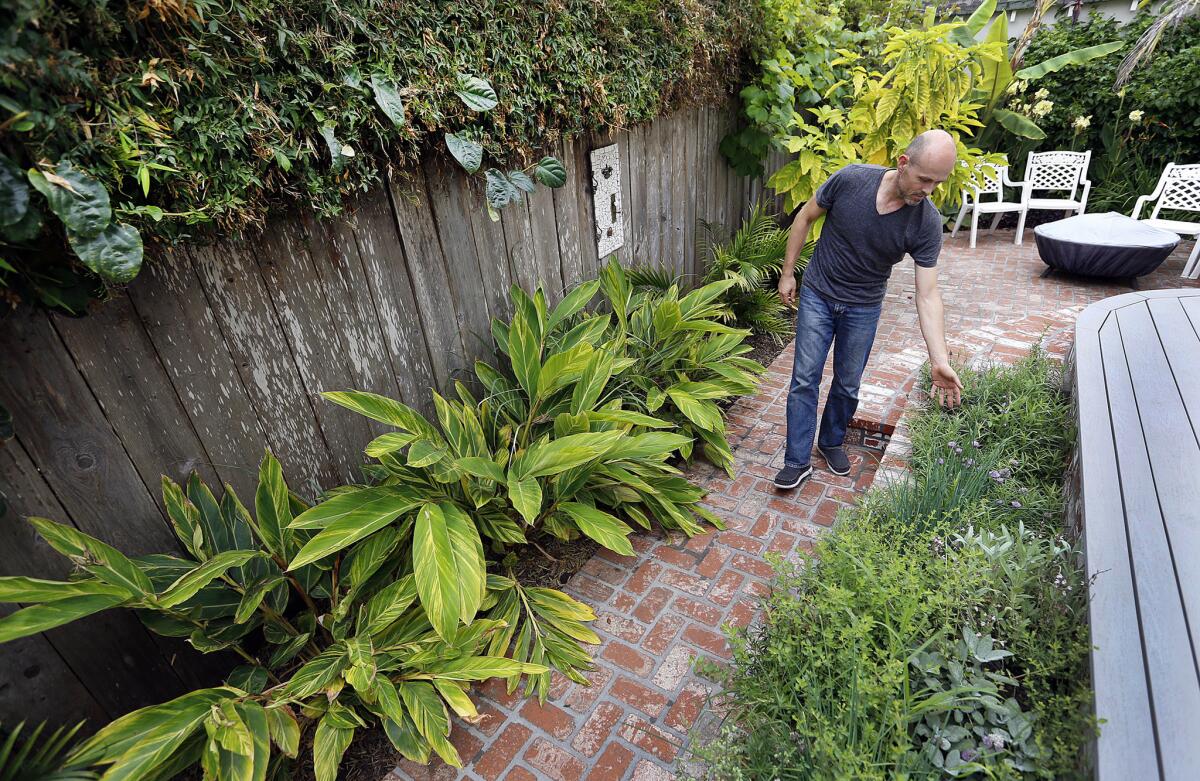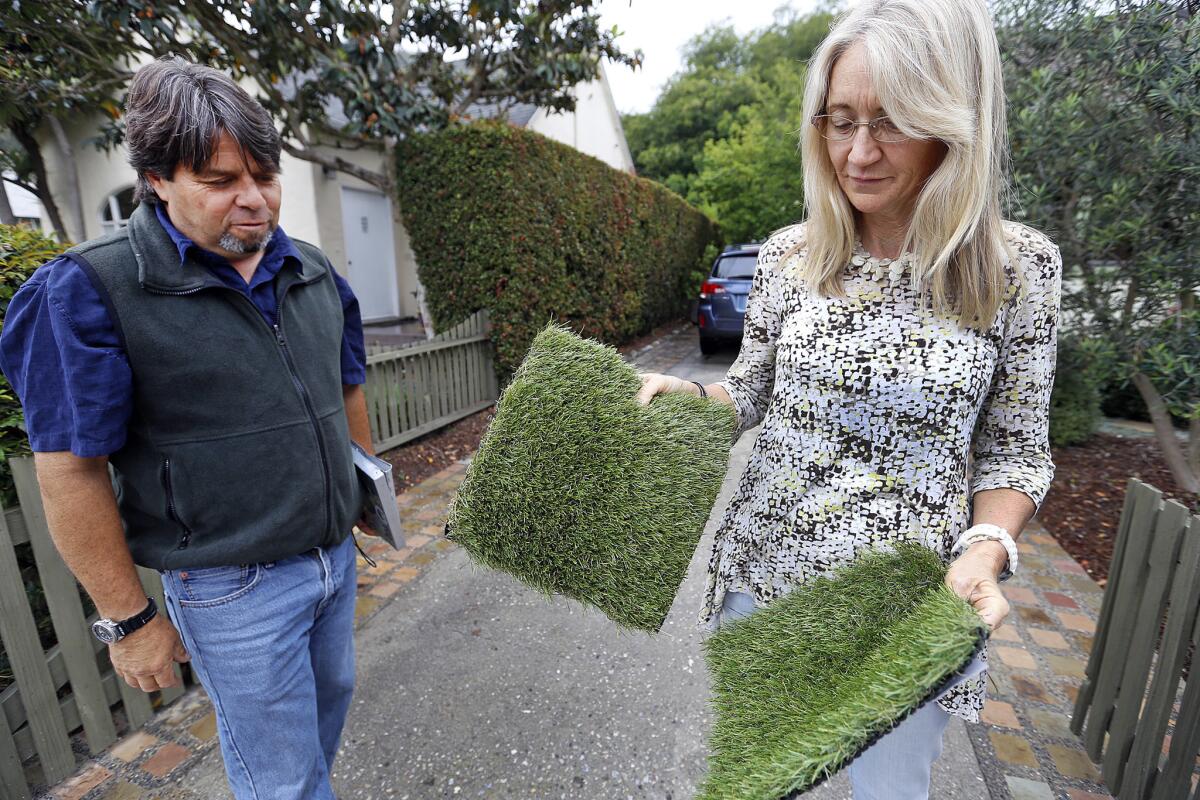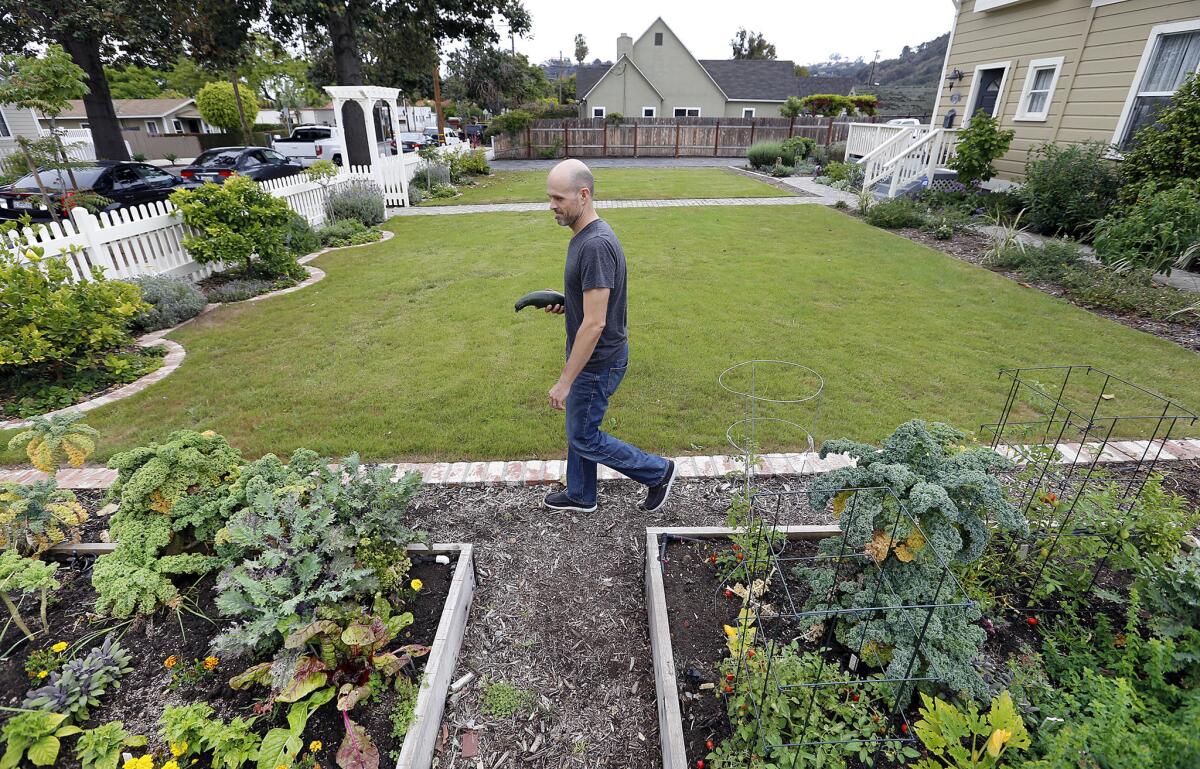How did some of California’s biggest water savers cut even more? By getting creative.

Cameron Clark’s back patio in Santa Barbara is filled with bananas, guava, passion fruit, ginger and an herb garden, which are fed by water diverted from the washing machine.
Californians could be justifiably proud earlier this fall when the State Water Resources Control Board reported that for the three steamy months of summer, the state had not only met Gov. Jerry Brown’s mandated 25% reduction in water use but had surpassed it by nearly 4%.
In several Southern California civic quarters, however, the feeling was closer to elation. Not only had these communities met their differing goals, they had gone far beyond them — as much as 25% above their particular conservation standard set by the state.
“It’s really a tribute to the community and their interest in doing the right thing,” says Shana Epstein, city of Ventura water general manager. Ventura, which had been tasked to reduce its usage by 16%, cut it 39.4% over the course of June, July and August — 23.4% over its mandate.
43 easy ways to save water at home -- without ditching the lawn
Santa Barbara did even better. The city cut its usage by 37.5% when it only needed to reduce it by 12% — three times more than its mandate.
In recent weeks, news reports have anticipated heavy El Niño rains in coming months, but a season’s rainfall — no matter how abundant — will not cure the drought that has plagued California in recent years. Californians still need to conserve, and Ventura and Santa Barbara offer strategies and tips that might work for the rest of us.
Why were they so successful?
The answers vary. In general, however, capturing consumer interest through a combination of vigorous educational messages and public programs, media attention and direct community involvement appears to have made a big difference.
“Our approach is multi-pronged,” says Madeline Ward, Santa Barbara’s acting water conservation coordinator. The city’s well-designed website includes easy-to-find information on programs and incentives, including free one-on-one water efficiency inspections by city irrigation specialists, turf removal and rebates, strong K-6 school education programs and frequent drought-related workshops with local collaborators.
“The way I can sum up the mission of our conservation program is that we are giving people the tools they need to modify their behaviors and make their properties more efficient,” Ward says.
Long memory has played a key role as well — the city suffered through a brutal drought from 1987 to 1991. “Because we had that history, it helped us gain momentum,” Ward says. “We’ve been asking people to conserve for 30 years. It’s very ingrained in them.”
Many residents had already switched to low-flow toilets and swapped out their lawns for drought-tolerant and native gardens. “We have a lot less grass in comparison to other communities,” Ward says.

Tyler Mata, a water specialist in Santa Barbara which cut its water usage by 37% talks to homeowner Meg Miller about her choices in installing artificial sod.
Another significant factor Ward points out — and one Santa Barbarans share with many Northern Californians — is that they have a personal link to at least one source of their water. “Our water supply is very visual,” she says. “It comes from Lake Cachuma,” which has sunk to 17% of its capacity. “People drive over the hill and they can see that the lake has gotten very low and is turning into a meadow.”
For Ventura, “it was a whole-city approach,” says Epstein. In summer 2014, the city appointed a drought task force with 13 community members. It was a proactive strategy with “a lot of communication and education first, before fines.” Members of Epstein’s department attended about 25 different community events with information and giveaways such as efficient shower heads and leak detection kits, and hosted weekend drought-related workshops.
The city got creative and started an annual online film contest, Water Take 1, in which filmmakers of all types focused on the importance of water. But “what really helped us,” Epstein says, “was branching out into radio and having that traditional medium play off social media.”
At the same time, the city launched a “dirty car” campaign, encouraging people to refrain from washing their cars, although not their windshields, and to post photos of their cars on the city’s Facebook page, with a monthly winner receiving a free detail job. The local radio station jumped onboard, sending out someone to drive around town and give prizes to the dirtiest cars.

Cameron Clark of Santa Barbara gathers vegetables from a garden he installed in an effort to do more with less water amid the ongoing drought.
This year’s summer campaign, “Hey Ventura, What’s Your Shower Song?,” asked people to post on social media their favorite five-minute-and-under songs to promote shorter showers.
Local merchants joined the effort. Earlier in the year, downtown businesswoman Debbie Fox, who owns a jewelry store, launched a “Gold Is the New Green” campaign to get people to stop watering their lawns, offering a $1,000 shopping spree at her shop (participants had to drop off photos of their lawns at her shop). She hosted her own water conservation event in August, where Epstein’s crew manned an information booth and set up a mock shower stall complete with bath toys for participants to take a photo to post on social media along with their song.
“It was very exciting. We were, ‘Really, she’s doing all that?’ ” says Epstein. What the city learned in this process, she says, is a sort of formula for success, seeking “any kind of partnership with business partners from the community and then letting it grow organically.
“Not,” she adds, “the typical thing government does.”
ALSO:
You’ve been watering your trees all wrong
It’s Dry Out There: 11 Inspiring water-wise landscapes
The 5 biggest misconceptions about watering your lawn and garden
More to Read
Sign up for Essential California
The most important California stories and recommendations in your inbox every morning.
You may occasionally receive promotional content from the Los Angeles Times.










